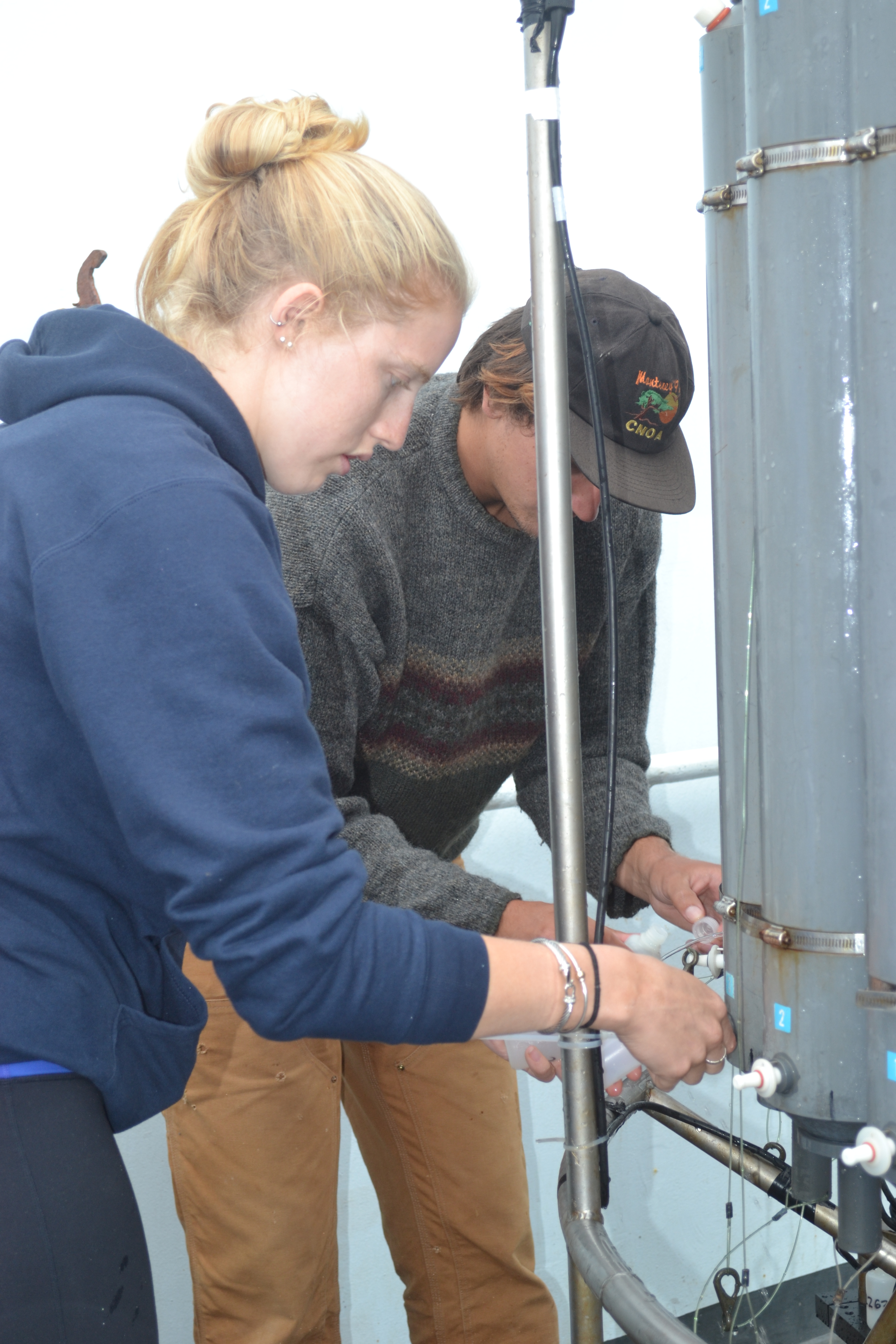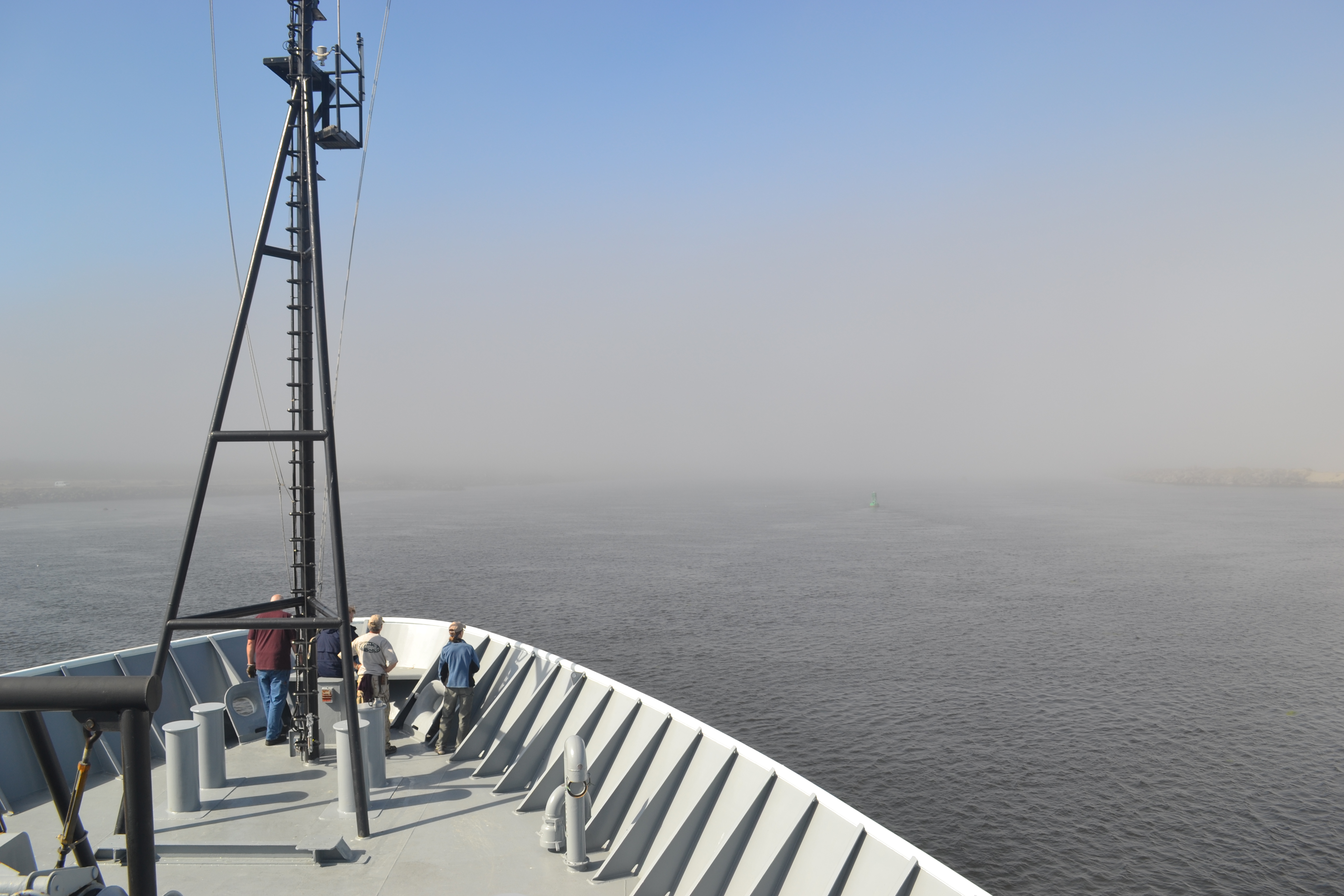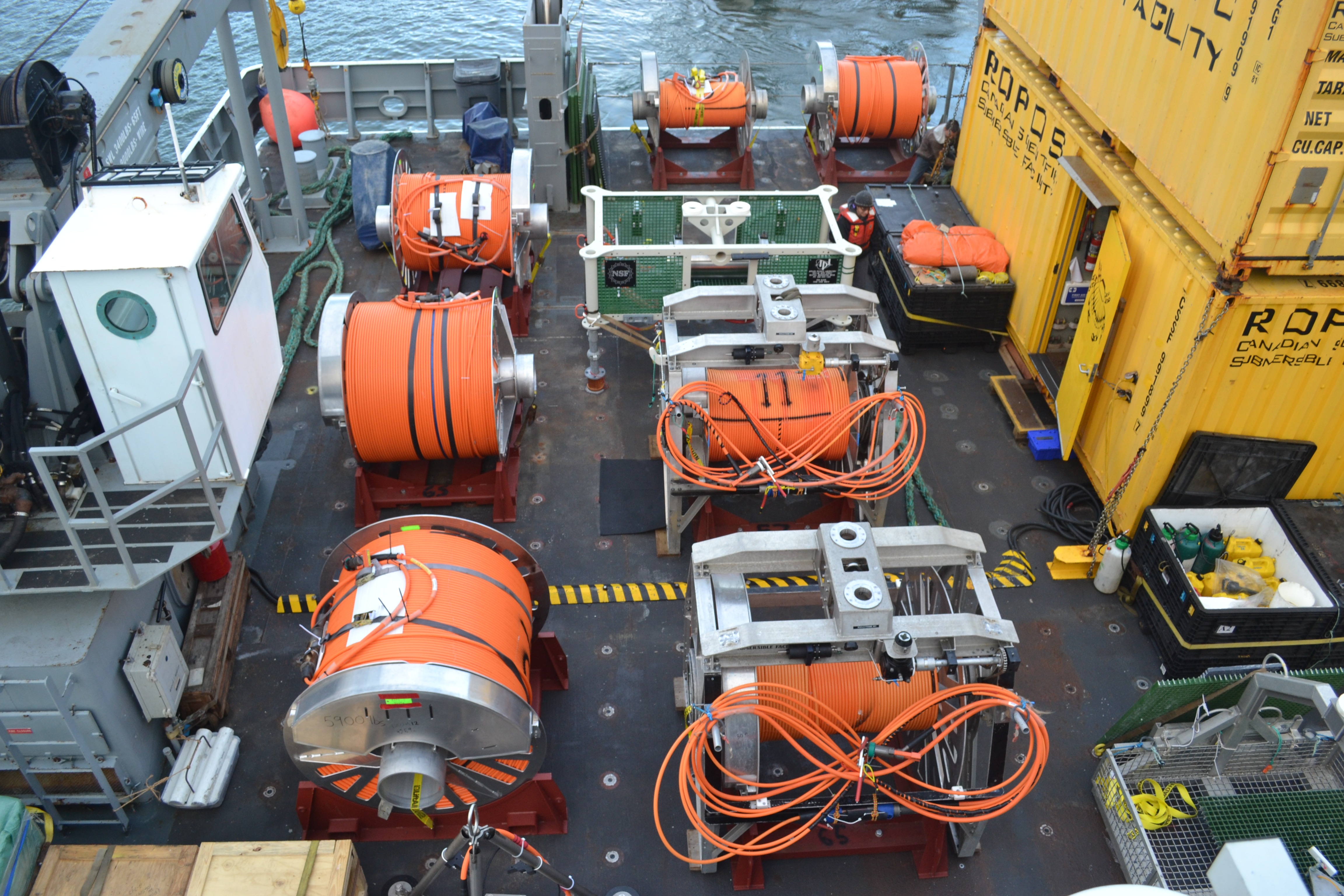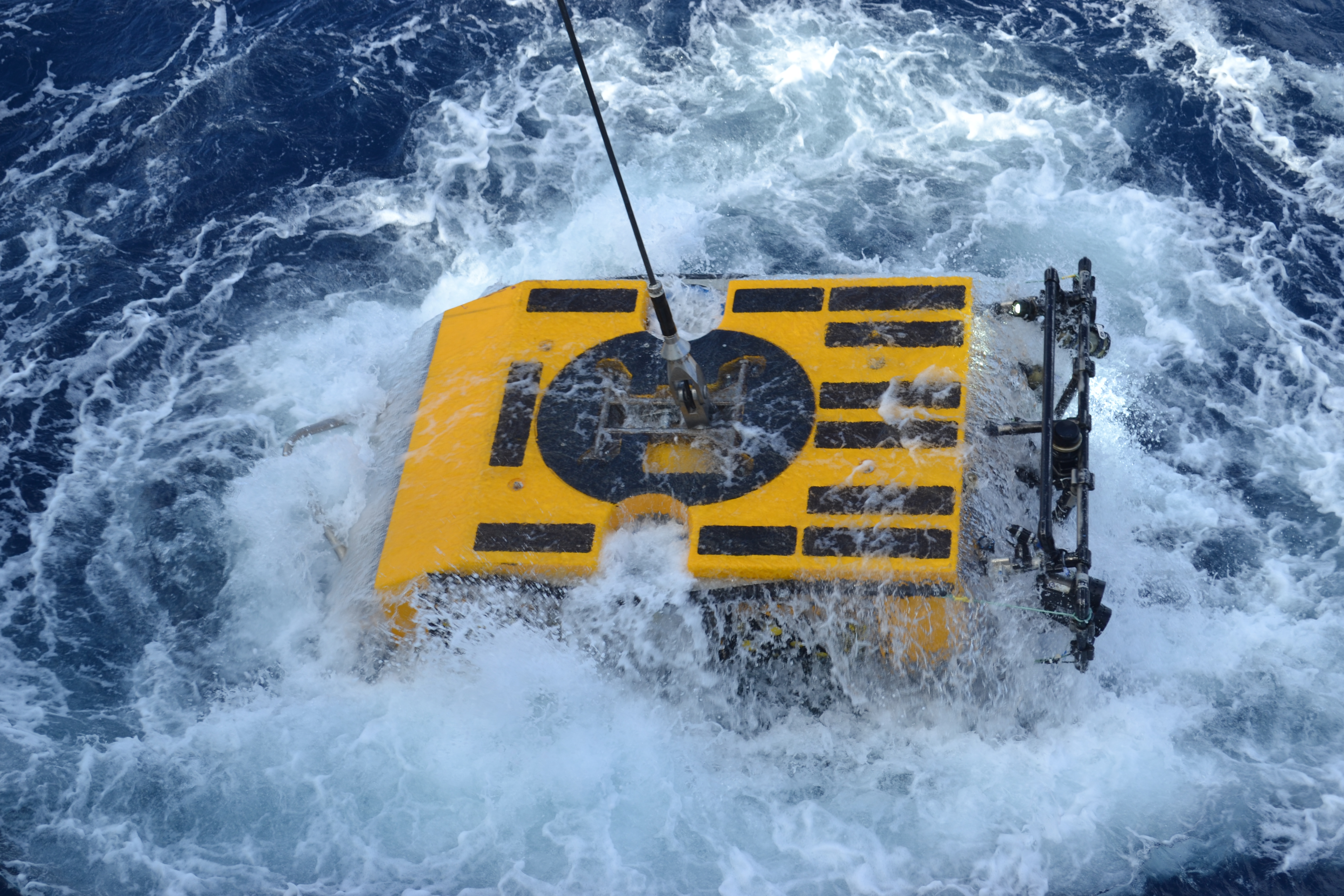Image Archive





























Caitlin looks at a microbial experiment brought up from hydrothermal diffuse flow site at the base of the chimney called Mushroom: water depth ~ 5000 ft. Photo Credit: Mitch Elend, University of Washington.

High-temperature, near-boiling fluids jet from small spigots on the top of the metal-sulfide, black-smoker chimney called El Guapo (the handsome one) in the International District Hydrothermal Field. VISIONS '13, Leg 4. Photo credit: NSF-OOI/UW/CSSF

Water streams off ROPOS as it is being recovered onto the deck of the R/V Thompson - it was a beautiful blue-sky day. Photo Credit: Mitch Elend, University of Washington. VISIONS '13, Leg 4

A break in the overcast days brings on great sunny weather for sampling water from the CTD. Photo Credit: Mitch Elend, University of Washingotn.

A Mola mola (or sunfish) gently passes by the R/V Thompson - they are the heaviest known bony fish. The other day we saw albatross picking parasites off of them as they wafted by. Credit: Mitch Elend, University of Washington, V13.

The ROV ROPOS powers up the RSN-OOI camera for the first time at the hydrothermal chimney called Mushroom. This image is from ROPOS with the vehicle lights off, and only the RSN-OOI HD camera providing illumination of the chimney while collecting the first video imagery from the seafloor, which was then streamed live over the Internet. Photo credit: NSF-OOI/UW/CSSF.

Caitlin and Andrew take water samples from a CTD cast ~ 125 km off the coast of Oregon to characterize fluids up to 9000 ft beneath the oceans surface.

A large Fried Egg Jellyfish (Phacellophora cantschatica) hugs the basalts along the floor of Axial Seamount. The jellyfish is likely a 'fried egg' jelly. Credit: UW/NSF-OOI/CSSF; ROPOS Dive R1635, V11.

A bit of relaxation time on a cloudy, but mild Sunday morning...Day 41 on the R/V Thompson for Brendan Philip. Photo Credit: Mitch Elend, University of Washington.

A 3D thermistor array designed by RSN Project Scientist Dr. Giora Proskurowski is deployed in the ASHES vent field for testing. A similar system will be deployed and powered up next summer, providing real-time 24/7 temperature data over the Internet for all to use/see. The blue cable holds 24 temperature sensors and was provided by RBR Ltd. The array will be placed in a diffuse flow site at the base of the vent called Mushroom, a site hosting abundant vent fauna. These data, coupled with seismic information, fluid chemistry, and HD imagery will be used to see how these systems evolve over time and how earthquakes influence chemical and biological processes. VISIONS '13, Leg 4 Photo credit: NSF-OOI/UW/CSSF

This 60-m extension cable will soon host a high-definition video camera to be deployed at the Mushroom hydrothermal vent (far left). White microbial mats along narrow fractures in the lobate lava flows mark areas where low-temperature diffuse hydrothermal fluids issue from the seafloor. The 7-function manipulator arms of the Canadian ROV ROPOS gently place the wet-mate connector holding plate on the seafloor. VISIONS '13 Leg 4 Photo credit: NSF-OOI/UW/CSSF.

The 3D thermistor array designed by RCA Project Scientist Giora Proskurowski is attached to the Medium Powered J-BOx (MJ03B) in the ASHES hydrothermal field. The array will be tested on a follow-on dive, and in 2014 it will be deployed in a diffuse flow site at the base of the vent called Mushroom, along with a high-definition video camera and an osmo vent fluid sampler. Credit: UW/NSF-OOI/CSSF; V13.

ROPOS decends to the seafloor during the VISIONS'13 expedition. Photo Credit: Mitch Elend, University of Washington

University of Washington undergraduate student Colin Katagiri and RSN Project Scientist Orest Kawka process fluids collected from ~ 125 off the coast of Newport Oregon at water depths from as great as 9000 ft beneath the oceans surface. Chemical and biological data collected on these samples will be used to optimize sampling strategies of sensors on cabled moorings to be installed at this site next year as part of the Ocean Observatories Initiative. VISIONS '13, Leg 4 Photo Credit: Mitch Elend, University of Washington.

The R/V Thompson crew watches from the bow as the Thompson transits through the channel our of Newport Oregon into the Pacific for the start of Leg 4 of the VISIONS'13 Expedition. Photo Credit: Mitch Elend, University of Washington.

Beautiful striated pillow basalts form a thick flow on the floor of Axial Seamount. Credit: UW/NSF-OOI/CSSF, ROPOS Dive R1630; V13

Dr. Danny Grumbaum and Owen Coyle are developing this sea-going, flow-through system. VISIONS '13, Leg 3

patchiness_in_the_ocean_adrianrembold

A crab picks its way across a glassy, jumbled lava flow in the caldera of Axial Seamount. VISIONS '13, Leg 4 Photo credit: NSF-OOI/UW/CSSF

Numerous spools of extension cables await deployment on Leg 3. When completed, the VISIONS13 program will have installed ~23,000 m of cable on the seafloor.

ROPOS enters the water on dive 1604 during VISIONS'13. Photo Credit. Mitch Elend.

Several members of the Leg 3 VISIONS'13 team gaze to the west upon leaving Newport at the start of VISIONS '13 Leg 3. Photo by Mary Miller

During Leg 4 of the VISIONS'13 cruise, old battery-powered transponders were recovered because they present navigation hazards. A sharp knife held in the manipulator is used to cut the 150-200 m tether at its base, and it and the transponder come to the surface where they are recovered on the ship. Photo credit: NSF-OOI/UW/CSSF

A fossilized lava pond reflects past circulation of melt on the seafloor in a small lava lake. The surface is glass, and fine sediments highight the whirl. VISIONS '13, Leg 4 Photo credit: NSF-OOI/UW/CSSF

A small spider crab walks gingerly across a broken, very glassy lava flow at the summit of Axial Volcano. Photo credit: NSF-OOI/UW/CSSF.

Beautiful sheet flow swirl with broken hackly edges. Credit: UW/NSF-OOI/CSSF; V13.

Close-up view of a microbial experiment (tubes at right) being conducted by Harvard University. The experiment is located in a diffuse flow site, surrounded by limpets, small tube worms and palm worms. In part, this study is designed to look at microbial utilization of sulfur in these systems. The green lasers from the ROV ROPOS are 10 cm apart. VISIONS '13, Leg 4 Photo credit: NSF-OOI/UW/CSSF.

oceanography_globalfuture_isaacstockdale
- Anemone
- Animal
- Arthropod
- ASHES
- Axial
- Axial Base
- Axial Biology
- Axial Caldera
- Bacteria
- Basalt Lava
- BEP
- Biofouling
- biolgoy
- Biology
- Camds
- Camera
- Camhd
- Central Caldera
- Ciliates
- Cnidaria
- Coastal Biology
- Crab
- Deep Profiler Mooring
- Dive Highlights
- Eastern Caldera
- Echinoderms
- Endurance Array
- Engineering Team
- ENLIGHTEN 10
- Exploratorium
- Fish
- Geology
- HD Camera
- HPIES
- Hydrate Ridge
- Hydrates
- Hydrophone
- Hydrothermal Vents
- Illustration
- Inshore 80 Meters
- Instrument
- International District
- J-BOX
- Jason
- Jellyfish
- Junction Box
- K12
- Lava
- Mollusk
- Moorings
- Nodes
- Nudibranch
- Octopus
- OOI
- Oregon Offshore
- Oregon Offshore 600 m
- Oregon Shelf
- Oregon Slope Base
- People
- PN1B
- PN1D
- Polychaetes
- PPSDN
- Primary Node
- RASFL
- ROCLS
- ROPOS
- ROPOS Dives
- ROV Team
- RV Revelle
- RV Sikuliaq
- RV Thompson
- Salp
- Sample
- SC13
- Science Team
- Sea Cucumber
- Sea Star
- Sea Urchin
- Seafloor
- Seismometer
- Sensors
- Shallow Profiler Mooring
- Shark
- Shipboard
- Shore Station
- Slope Base
- Smoker
- Soft Coral
- Southern Hydrate Ridge
- Sponge
- Squid
- Students
- Students & Guest Participants
- Tmpsf
- Tubeworms
- VISIONS 11 Leg 1
- VISIONS 11 Leg 2
- VISIONS 11 Viewers
- VISIONS 13
- VISIONS 14
- VISIONS 15
- VISIONS 16
- VISIONS 17
- VISIONS 18
- VISIONS 20
- VISIONS 22
- VISIONS 23
- Visualization
